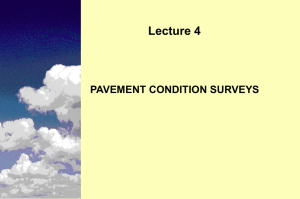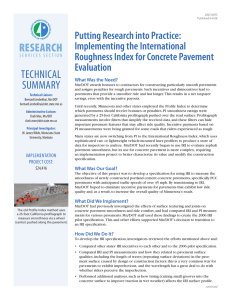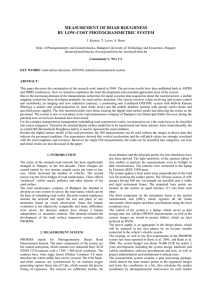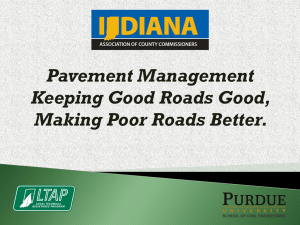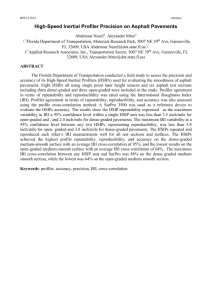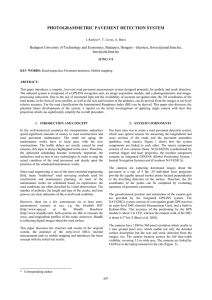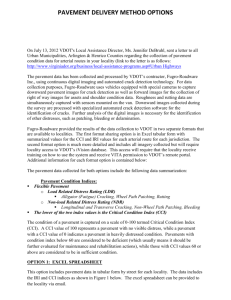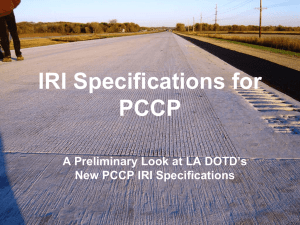AASHTO Proposal of Performance Measures
advertisement
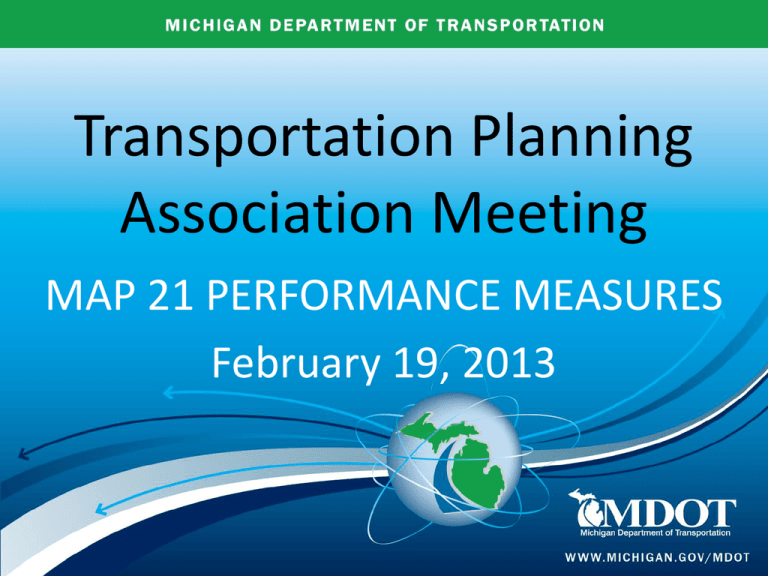
Transportation Planning Association Meeting MAP 21 PERFORMANCE MEASURES February 19, 2013 Task Force on Performance Measures Paul Degges–Chair TN Bernie Arseneau–Vice Chair MN Mal Kerley – VA Judith Corley-Lay – NC Grant Levi – SD John Barton –TX Rick Land – CA Lynn Zanto – MT Daniela Bremmer - WA • • • • • • • Tim Gatz – OK Tim Hinkle – MN Mark Van Port Fleet – MI John Selmer- IA Nile Easton-UT Lori Richter –WI Christopher Xenophontos-RI Six Principles • • • • • • There is a Difference Specificity and Simplicity Possession is 9/10ths of the Law Reduce and Re-use Ever Forward Communicate, Communicate, Communicate Safety • Number of Fatalities – Five year moving average of the count of the number of fatalities on all public roads for a calendar year • Fatality Rate – Five year moving average of the Number of Fatalities divided by the Vehicle Miles Traveled (VMT) for a calendar year Safety Continued • Number of Serious Injuries – Five-year moving average of the count of the number of serious injuries on all public roads for a calendar year. • Serious Injury Rate – Five-year moving average of the Number of Serious Injuries divided by the Vehicle Miles Traveled (VMT) for a calendar year. Safety Issues • Lag in availability of the Fatal Accident Reporting System (FARS) from NHTSA • No uniform definition of serious injury • Target setting and penalities • Recognition of high performing state • Low volume states like ND, WY, MT • How is performance met with 4 factors Pavement Condition Interstate Pavement Condition in Good, Fair, and Poor Condition based on the International Roughness Index (IRI) – Percentage of 0.1 mile segments of Interstate pavement mileage in good, fair, and poor condition based on the following criteria: good if IRI<95, fair if IRI is between 95 and 170, and poor if IRI is greater than 170. Pavement Condition Continued • Non-Interstate NHS Pavement in Good, Fair and Poor condition based on International Roughness Index (IRI) - Percentage of 0.1 mile segments of Non-Interstate NHS pavement mileage in good, fair, and poor condition based on the following criteria: good if IRI<95, fair if IRI is between 95 and 170, and poor if IRI is greater than 170. Pavement Condition Continued • Pavement Structural Health Index – Percentage of pavement which meet minimum criteria for Pavement faulting, rutting, and cracking. Pavement Issues • • • • IRI not uniformly defined. Difference between functional class IRI not a health index Performance Penalty could lead to poor asset management Bridges • Percent of Deck Area on Structurally Deficient Bridges – NHS bridge deck area on structurally deficient bridges as a percentage of the total NHS bridge deck area. • NHS Bridges in Good, Fair, and Poor Condition based on Deck Area – Percentage of National Highway System bridges in good, fair and poor condition, weighted by deck area. Bridge Issues • Move toward element level data coming • Better opportunities for Good, Fair, Poor Condition rating system Freight • Annual Hours of Truck Delay – Travel time above the congestion threshold in units of vehicle hours for Trucks on the Interstate Highway System • Truck Reliability Index (RI80) – The RI is defined as the ratio of the total truck travel time needed to ensure on-time arrival to the agency-determined threshold travel time (e.g., observed travel time or preferred travel time.) System Performance • Annual Hours of Delay (ADH) – Travel time above a congestion threshold (identified by State DOT’s and MPO’s) in units of vehiclehours of delay on Interstate and NHS corridors. • Reliability Index (RI80)- The Reliability Index is defined as that ration of the 80th percentile travel time to the agency-determined threshold travel time. Freight and System Performance Issues • Implementation of and AHTD performance measure is dependent on U.S. DOT providing data to State DOT’s and MPO’s private sector speed and vehicle miles traveled from HPMS volume data and the respective analysis tools. • Definition of corridors segments is key. • Threshold setting is key Congestion Mitigation and Air Quality • Criteria Pollutant Emissions – Daily kilograms of on-road, mobile source criteria air pollutants (VOC, NOx, PM, CO) reduced by the latest annual program of CMAQ projects. • Annual Hours of Delay (ADH) – Travel time above a congestion threshold (defined by State DOT’s and MPO’s) in units of vehiclehours of delay reduced by the latest annual program of CMAQ projects. Next Steps • FHWA to publish proposed measures in Federal Register • Come in Stages not all measures at once. • AASHTO to Comment • Individual States and MPO’s to comment • Implementation still 2 years away. Compete report • Go to AASHTO Standing Committee on Performance Management and click on SCOPM Task Force Findings on National Level Measures or the following link • http://scopm.transportation.org/Documents/ SCOPM%20Task%20Force%20Findings%20on %20National%20Level%20Measures%20FINAL %20(11-9-2012).pdf QUESTIONS???

